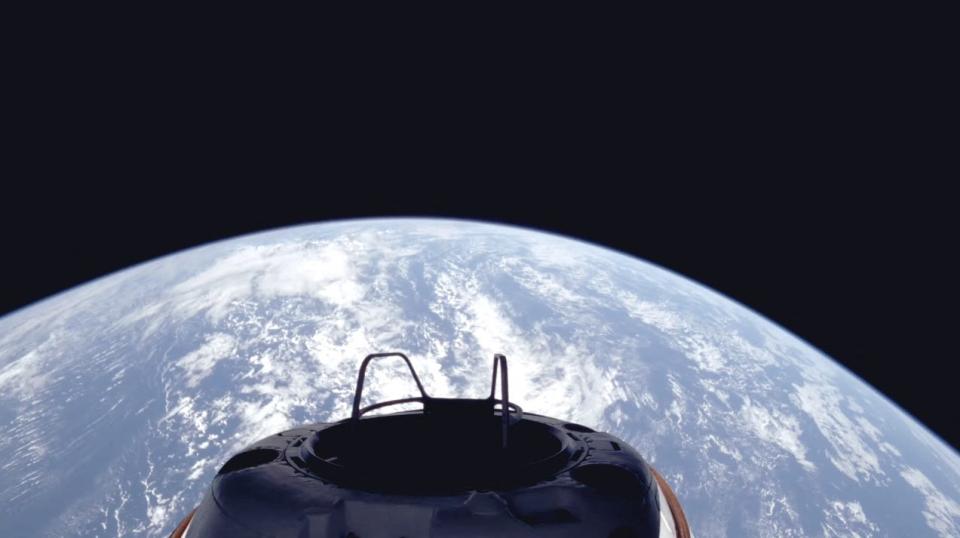Polaris Dawn mission update: SpaceX Dragon takes crew to highest orbit in 50 years
The four astronauts of the Polaris Dawn mission have now traveled further into outer space than any human has gone in more than half a century.
After launching Tuesday aboard a Falcon 9 rocket, the SpaceX Dragon capsule carrying the crew managed to ascend to 870 miles above Earth's surface, the company announced on social media site X. The height is the highest any spacefarer has traveled since NASA's Apollo era came to an end in the 1970s.
For Polaris Dawn mission specialists Sarah Gillis and Anna Menon, the milestone came with even more history: The two astronauts have now traveled farther from the planet than any other women ever have.
Polaris Dawn and Dragon at 1,400 km above Earth – the farthest humans have traveled since the Apollo program over 50 years ago pic.twitter.com/rRDeD1dY1e
— SpaceX (@SpaceX) September 11, 2024
Under the command of billionaire entrepreneur Jared Isaacman, the commercial crew of the ambitious Polaris Dawn mission is now in its second of five days in orbit. Ahead of them is a bold pioneering private spacewalk, which SpaceX said is still on track to occur Thursday.
Isaacman, who funded the mission with SpaceX, will also lead the crew in testing out SpaceX technology that could be pivotal for future deep space exploration.
Rewatch Polaris Dawn launch: Video shows SpaceX rocket launch 4-member crew for daring commercial mission
Polaris Dawn mission launches after delays

The Polaris Dawn crew were finally able to embark early Tuesday on the thrice-delayed spaceflight.
In the predawn hours, the SpaceX Dragon capsule perched atop a Falcon 9 rocket lifted off at 5:23 a.m. EDT from NASA's Kennedy Space Center in Florida. By 5:40 a.m., the Dragon spacecraft broke away from the Falcon 9's upper stage and began using its own thrusters to power on, SpaceX said X.
The highly-anticipated launch followed more than two weeks of delays as SpaceX awaited the ideal time to schedule a launch opportunity.
Once they were rocketing out of Earth's atmosphere, it was a matter of hours before the crew reached a height more than three times higher than the International Space Station. The height was not only the highest humans have reached in 50 years, but also marked the highest that the SpaceX Dragon has flown to date, SpaceX said in a day one update.
The ascent took the Polaris Dawn crew through the treacherous inner regions of Earth's Van Allen radiation belts, which astronauts will have to traverse on future missions to the moon and Mars. After the spacecraft reached 870 miles above Earth's surface, the dragon was to descend to a cruising orbit about 435 miles above Earth.
Once in orbit, the crew was able to remove their spacesuits and begin making preparations for the tests and experiments they hope to conduct during the mission, SpaceX said. Two hours into the flight, they had their first meals and began testing a new laser-based satellite communication system using Starlink.
Preparing for a risky spacewalk
The Polaris Dawn crew, which also includes pilot Scott “Kidd” Poteet, also began preparations Tuesday for what may be the highlight of the mission: The first-ever commercial spacewalk.
Until now, spacewalks have only ever been the purview of government astronauts like those on NASA missions. What's more, the complex orbital maneuvers most often take place in vehicles with airlocks that negate the need to depressurize an entire capsule.
But because the Dragon does not have an airlock, the entire spacecraft will have to be depressurized when the hatch is opened. When that happens, the entire crew will be exposed to the vacuum of space and will need to wear extravehicular activity (EVA) suits designed by SpaceX to receive oxygen through tethers.
Shortly after liftoff, the Dragon's pressure began to slowly lower while oxygen levels inside the cabin increased, helping to purge nitrogen from the crew members' bloodstreams. The protocol is intended to prepare them for the spacewalk and lower the risk of decompression sickness, SpaceX said.
Polaris Dawn spacewalk time
SpaceX has scheduled the spacewalk to occur at 2:23 a.m. EDT. If needed, a backup opportunity is available at the same time Friday.
A live webcast will begin about one hour prior to the spacewalk on social media site X.
What is the Polaris Dawn mission?
Polaris Dawn is the first of three human spaceflights under the Polaris Program, all of which are intended to test SpaceX technologies needed to carry humans deep into the cosmos.
Isaacman, founder of internet company Shift4 Payment who helped to fund the mission along with Elon Musk's SpaceX, is the only member of the Polaris Dawn crew to have been to outer space before. Menon and Gillis are also now the first SpaceX employees to travel to space.
Years in the making, the launch was most recently scrubbed due to poor weather conditions forecasted for the crew's return to Earth. Because the Dragon is not docking at the International Space Station, its crew will be entirely reliant on the oxygen and supplies they have stored on the spacecraft, which is only enough for about a week, Isaacman previously explained on social media site X.
For that reason, SpaceX waited for several days for weather conditions to improve off the Florida coast, where the crew will make a splashdown landing on the sixth day of their mission.
Eric Lagatta covers breaking and trending news for USA TODAY. Reach him at [email protected]
This article originally appeared on USA TODAY: SpaceX Polaris Dawn update: Astronauts reach highest orbit in 50 years
